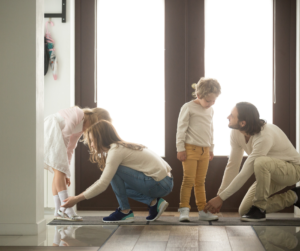
How confident are you that you know your child’s true shoe size? *A survey of 2109 parents showed that 65% did not correctly identify their children’s shoe sizes when compared against accurate foot measurements for the kids. Moreover, kids were found to be wearing shoes up to two sizes too small.
With 30% of our patients being children here at My FootDr, we often see the effects of shoes being too small, like claw toes, bunions and more. Today, we’re sharing what this statistic means, why parents get it wrong, and what you can do to measure your child’s shoe size accurately.
Why Can Parents Get It Wrong?
Children’s feet grow and change quickly and inconsistently, so it can be difficult for parents to know when their children’s shoes are too small and need replacing. This is particularly true if they use the same sizing methods their parents did, such as:
- Holding a shoe up against their children’s feet and not taking into account lining and seams
- Squeezing the ends of the shoe to feel for the toes, causing a reflex for the child to draw the toes up
- Tracing around their children’s feet if they don’t come to the store with them
- Asking kids how the shoe feels when they don’t understand what they’re feeling for
As a result, it was found that 18% of kids were wearing shoes that were two sizes too small, and 47% were wearing shoes that were one size too small. While the shoes may have been a good fit to start with, this is a great reminder of how important it is to regularly check the sizing.
What Are The Consequences?
Wearing shoes that squeeze the feet can permanently alter the alignment of the bones, as well as cause other pains and sores. Common examples include:
 Bunions
Bunions - Tailor’s bunions (affecting the little toe instead of the big toe)
- Claw toes
- Hammertoes
- Blisters
- Corns
- Callus
- Haglund’s deformity (a bump at the back of the heel)
- Swelling
- Pain
- Shortening foot muscles
A 2009 study found a significant relationship between the development of bunions and wearing footwear that was too short in length. This same study also found that over 88% of the 808 children studied wore shoes that weren’t long enough, further emphasising the extent of the problem.
Signs That The Shoes No Longer Fit
Your child’s shoes have likely had their run if:
- The longest toe on the larger foot starts to hit the end of the shoe. Note – this isn’t always the big toe!
- You notice redness, blisters, callus or corns when the shoes are removed
- The shoes are bulging at the sides
- There is any pain around the feet or ankles
Choosing The Right Shoe Size
 The best way to ensure that your child’s shoes are the right fit is to have them measured in-store. Luckily, many shoe shops offer this as a free service! These measurements are quick and easy, so should be done every time you go shopping, especially if it has been over two months since you last purchased shoes. Additionally:
The best way to ensure that your child’s shoes are the right fit is to have them measured in-store. Luckily, many shoe shops offer this as a free service! These measurements are quick and easy, so should be done every time you go shopping, especially if it has been over two months since you last purchased shoes. Additionally:
- Have at least 12mm between the end of the longest toe on the biggest foot and the end of the shoe liner
- Remember that sizing may differ between brands, so consider the actual size of the shoe in front of you and not the number on the box
- Check if your child’s shoes are still fitting every one to two months
- Don’t rely on your child telling you it’s too tight – they may not realise what they’re feeling and enjoy the snug fit
- As children’s feet are often flat, make sure there is enough width to accommodate their feet well
- Be mindful of the socks that they’re wearing, especially if they wear thick winter socks
- Check the shoe is deep enough and isn’t too tight where they lace-up
- Buy shoes in the afternoon, as feet can swell throughout the day
Worried About Your Child’s Feet?
If you’re worried about your child’s feet or you have been noticing any pains or problems, bring them in to see their My FootDr Podiatrist for an appointment. We can check their shoe size too! We love helping kids with their foot health, so that they can lead happy and active lives.
Click here to book your appointment
Get back to school ready with our '$95 Comprehensive Initial Consult' offer, book online here!

